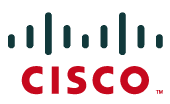 Cisco
Cisco celebrated a major milestone with the distribution of its 30 millionth Internet Protocol phone to one of the world's largest banking and financial services institutions, HSBC. As part of a standardization strategy to enable a uniform groupwide global standard, HSBC has already deployed over 100,000 Cisco Unified IP Phones across 87 geographic locations.
HSBC is using Cisco's Unified IP phones and Cisco Unified Communications Manager as they have found that standardization, consolidation and simplification further improves system performance, helps increase organizational agility and reduces the cost of supporting infrastructure. In addition, intelligent call routing, a single directory and a standardized dial-plan foster greater employee collaboration to help HSBC develop strategies to serve its customers better. By providing device identity, digital signed images, call tracing, and call recording, Cisco's IP phones provide HSBC with enterprise-level security to keep conversations of a sensitive nature confidential, as well as providing support for various device functions and applications directly on the handsets.
Having begun the deployment of the Cisco Unified IP Phones over 18 months ago, HSBC is halfway through a three-year global program that will result in a total installed base of 354,000 Cisco devices by the end of 2012. With investments in communications and collaboration technologies such as Cisco TelePresence, Cisco Unified IP phones and Cisco WebEx, HSBC is aiming to significantly lower its carbon dioxide emissions by reduced business travel in 2012.
Cisco made its first Voice over IP phone call in 1997 and sold its first Cisco Unified IP Phone in 1998. In the last 13 years, Cisco Unified IP Phones have evolved beyond voice to connect people with video technology, and act as interfaces to networked applications, services and content. They are part of a new collaboration experience that is rich, integrated, mobile, and often virtualized.